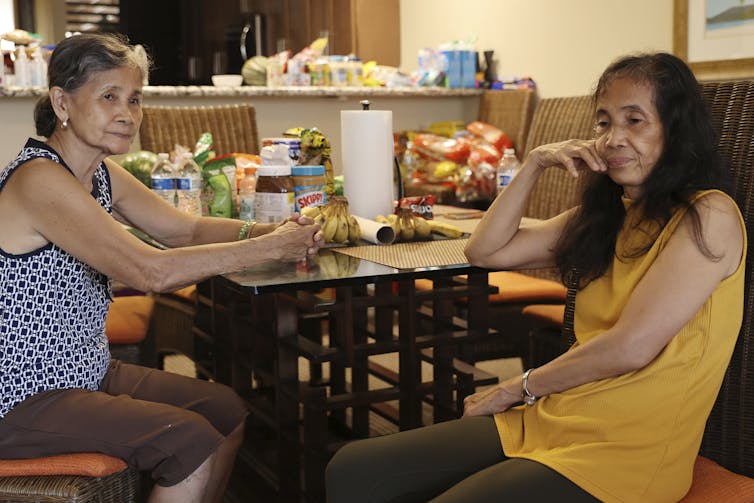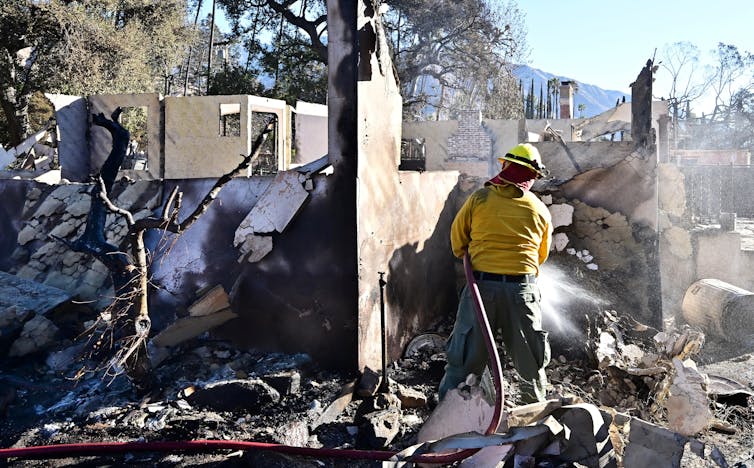Los Angeles was in trouble in January 2025 when historic fires broke out in many neighborhoods, destroying thousands of homes. Conversation America spoke with Vanessa Crossgrove Fry, associate research professor and director of the Idaho Policy Institute at Boise State University and an expert in sustainable management and nonprofit management. Ask her to explain what role nonprofits can play in averting and responding to disasters when they occur. and after they happen.
What role do nonprofits play when disaster strikes?
They play a critical role by complementing government efforts and filling gaps in immediate and long-term recovery needs.
Collaboration is a hallmark of nonprofit responses to disasters. These organizations often work together with government agencies and private sector partners. This approach ensures efficient distribution of aid, directing resources to where they are most needed.
Often, national groups take the lead in setting up emergency shelters, distributing food and water and providing mental health support. In the best cases, these large organizations partner with local nonprofits that are uniquely positioned to mobilize quickly by leveraging their deep understanding of community needs and building trust with residents.
In some disasters, especially large ones like the 2023 Lahaina fires in Hawaii, nonprofits also serve as coordinators. They ensure volunteers, donations and other resources flow to those in need.
The flexibility and community-based networks of nonprofits allow them to respond to local challenges, such as supporting displaced families or addressing unmet needs in underserved areas. In addition to immediate relief, many nonprofits remain involved in long-term recovery efforts, assisting in rebuilding homes, restoring livelihoods, and building community resilience.

What do nonprofits do before a disaster strikes?
Nonprofit organizations play a vital role in disaster preparedness by working to reduce risk and build resilience.
In fire-prone areas like the Los Angeles foothills, organizations often focus on educating the public, helping residents understand fire risks and develop evacuation plans. They also implement fire prevention strategies, such as promoting the importance of clearing brush and replacing wooden roofs.
Nonprofits also develop community training programs, such as cardiopulmonary resuscitation (CPR) certification or community emergency response team (CERT) training or sound the alarm campaigns, to equip residents to respond effectively in emergencies.
Through Community Emergency Response Team (CERT) training, local fire departments can prepare volunteers to respond to possible hazards in their communities. This exercise equips them with basic disaster response skills, including fire safety and light search and rescue knowledge. During the "Sound the Alarm" campaign, smoke detectors are installed in vulnerable communities and residents can receive help with evacuation plans.
Ideally, partnerships should be established with government agencies, private companies, and other nonprofit organizations before a disaster occurs to ensure a coordinated response when a disaster strikes.
For example, nonprofits may enter into agreements to establish emergency shelters or obtain and distribute food supplies. They also build networks to ensure that vulnerable groups such as low-income residents, homeless people, and people with disabilities are included in disaster planning and response efforts.
Other roles include advocating for more funding for disaster preparedness and infrastructure, such as wildfire-resistant buildings or community-wide firebreaks (areas where vegetation has been cleared).
In some cases, nonprofit organizations may help coordinate the use of government resources. For example, Dean Cameron, director of the Idaho Department of Insurance, recently authored a bill pending in the Idaho Legislature that would provide funding for homeowners to make fire protection upgrades to their properties.
Additionally, nonprofits often develop detailed contingency plans for their own operations in order to continue providing services during a crisis.
Through these proactive measures, nonprofits help communities prepare for the worst while building resilience and mitigating the long-term impacts of disasters.
What do the situation in Los Angeles and the situation in Idaho have in common?
Los Angeles and Idaho may seem very different, but they face strikingly similar challenges when dealing with disasters like wildfires.
Both places are dealing with dry spells, rising temperatures and an increase in invasive vegetation that heighten wildfire risks. Climate change is exacerbating these conditions, making fires more frequent and severe.
In Los Angeles, urban sprawl has pushed development into fire-prone areas, where wildlands meet the city. Likewise, development is accelerating in the wildland-urban interface around Boise, Idaho, where the population is booming.
This type of growth poses significant risks to homes and lives, as seen with the 2016 Table Rock Fire in Idaho and the more recent 2024 Valley Fire.
Additionally, wildfires in Idaho’s forests and rural areas not only put people and infrastructure at risk, but can also impact valuable rangeland, as the 2024 Red Deer Fire did.
In both regions, balancing housing needs with the need for fire planning and mitigation measures is a serious challenge.
Another common concern among nonprofits in Idaho and California is ensuring that vulnerable populations receive adequate support during and after disasters. Whether in urban or rural areas, homeless people, low-income families, and people in remote areas can encounter difficulties in evacuating, accessing resources, and rebuilding after a disaster.

What are some common misconceptions about nonprofits in disasters?
Many people tend to think of nonprofits as providing only immediate relief, such as food, shelter, or medical care. While these services are critical in the early stages of a disaster, many nonprofits are also focused on long-term recovery and reconstruction efforts.
Nonprofits can help communities rebuild their homes, restore livelihoods or address emotional trauma months or even years after a disaster.
People also tend to overlook the role of local nonprofits. High-profile national organizations often capture the public's attention, but local nonprofits are often better positioned to meet the specific needs of their communities and work directly with vulnerable populations.
These misconceptions can result in local nonprofits being underfunded and underappreciated.
Should people still donate to existing organizations?
There are now more ways to help people going through a crisis than in the past.
After a major disaster like the Los Angeles fires, you might be hesitant to donate to a large nonprofit for a number of reasons. Maybe you're concerned about transparency or the effectiveness of your group. This may not be as personal to you as donating to a GoFundMe campaign.
I think people should still consider donating to large, established organizations, but I also think it's important to do so thoughtfully. Large nonprofit organizations such as the American Red Cross or the Salvation Army often have the infrastructure, expertise, and logistical capabilities to quickly mobilize and scale up their operations to effectively respond to disasters.
These organizations also maintain established relationships with government agencies, local nonprofits, and international partners. These networks facilitate coordinated responses that may be difficult for smaller or newer groups to achieve.
However, the emergence of donation options such as crowdfunding platforms, grassroots campaigns, and community nonprofits have increased the opportunities for individuals to provide support to specific causes or groups of people. These pathways can have a big impact, especially when donors want to address local or niche needs. However, newer or less established groups may lack transparency or accountability.
Mature organizations tend to have robust financial oversight and accountability systems. They are often better equipped to meet not only immediate rescue needs but also long-term recovery efforts that smaller or informal groups may not have the capacity to support.
To be sure, it's always wise to do some research before donating to any type of cause.
Ultimately, the choice comes down to your own priorities. Do you want to support immediate relief, contribute to systemic solutions, or help a specific community?
By donating to large and local organizations, you can maximize your impact and help ensure everyone in your community is supported. This is important, especially after a major disaster like the Los Angeles wildfires.